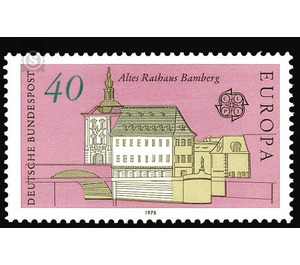Europe - Germany / Federal Republic of Germany 1978 - 40 Pfennig
Theme: Architecture
| Country | Germany / Federal Republic of Germany |
| Issue Date | 1978 |
| Face Value | 40.00 |
| Color | violet |
| Perforation | K 14 |
| Printing Type | combined intaglio and offset printing |
| Stamp Type | Postage stamp |
| Item Type | Stamp |
| Chronological Issue Number | 858 |
| Chronological Chapter | GER-BRD |
| SID | 92871 |
| In 40 Wishlists | |
The countries of the European Conference of Postal and Telecommunications Administrations (CEPT) decided at the meeting of their "Post" commission on 15 April 1975 in Malaga-Torremolinos to select the theme "Monuments" for the European brands in 1978. The German Federal Post Office chose the Old Town Halls of Bamberg, Regensburg and Esslingen am Neckar. The Middle Ages and Baroque have shaped the face of Bamberg. The Old Town Hall also recognizes this: on the one hand it owes its special location to the Middle Ages and on the other hand it is a typical testimony to the Bamberg Baroque. Its striking location in the middle of the left bank of the Regnitz, which separates the mountain area from the old town, the island city, is partly due to the special legal conditions in the prince-bishop residence city. These led in the Middle Ages to tensions between citizens of the city and the inhabitants of the districts, which were judicially and congregationally subordinated to the clergy. Therefore, the tower on the Upper Bridge was built exactly where episcopal and bourgeois city collided. The adjoining town hall building, also attested in the 14th century, had to be renewed in the years 1450-1463. This gothic building is hidden under the baroque robe, which was given to the town hall in the middle of the 18th century. The bourgeois, experienced and bourgeois prince-bishop Friedrich Karl Graf von Schönborn commissioned his court architect Johann Jakob Michael Küchel with the reconstruction of the Inselrathaus. Among his special jewelery are the sculptures of Bonaventure Joseph Mutschele at the tower and the frescoes by Johann Anwander on the walls of the town hall, which, through their colossal order, increase their monumental appearance. Thus, the town hall, the tower and the two bridges together with the Rottmeisterhaus on the breakwater form a picturesque architectural image of unique beauty. (Text: Historical Museum, Bamberg)


